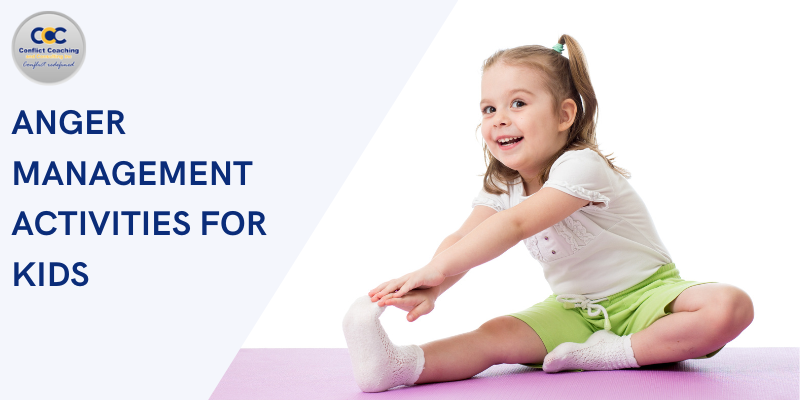
Anger Management Activities for Kids
Your child’s face flushes red, their small fists clench, and a toy goes flying across the room. In that moment of pure frustration, it’s clear: their anger has completely taken over.
As a parent or caregiver, you’re left feeling helpless, frustrated, and wondering how to help them deal with these overwhelming feelings that seem to erupt out of nowhere.
The truth is, anger is a normal, healthy, and universal emotion. But for a child whose brain is still developing the circuitry for self-control, it can feel terrifying, leaving them (and you) feeling overwhelmed and disconnected.
The good news is that these challenging moments are not signs of failure, but opportunities for connection and teaching.
Through playful, guided anger management activities for kids, children can learn to identify their emotions.
They can learn to understand what their feelings are trying to tell them, express them safely, and find their way back to calm.
This guide explores a wide range of creative, practical, and engaging approaches that make learning to manage anger an adventure, not a chore.
The Brain Science Behind a Child’s Anger

Before explaining the activities, it’s necessary to understand what’s happening inside a child’s brain when they get angry.
The amygdala, the brain’s alarm system, is fully operational from birth. However, the prefrontal cortex (the part responsible for logical thinking, impulse control, and calming down the amygdala) is under construction well into a person’s twenties.
When a child feels threatened, frustrated, or unfairly treated, their amygdala sounds the alarm, flooding their body with stress hormones like adrenaline and cortisol.
This “fight or flight” response is a survival instinct, which is why an angry child might hit, scream, or throw things. They aren’t trying to be manipulative; they are, quite literally, overwhelmed.
Anger management for kids, therefore, is not about punishment or suppression. It’s about teaching them to be the boss of their amygdala. It’s about building a strong “mental muscle” in their prefrontal cortex through practice and play.
Why Anger Management Is Essential for Kids?
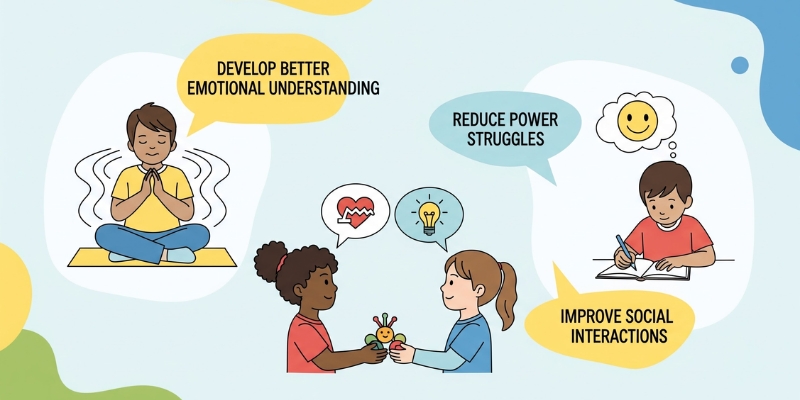
Anger in children is often a mask for other, more vulnerable feelings like hurt, fear, embarrassment, shame, or deep frustration.
When a child doesn’t have the vocabulary or skills to express these underlying emotions, they get channeled into the more primal, powerful language of anger, resulting in yelling, hitting, or full-blown meltdowns.
Engaging in structured anger management activities for kids provides a vital outlet and education. These activities help children:
- Develop Better Emotional Understanding: They learn to name their feelings, which is the first step in taming them. A child who can say, “I feel furious!” is less likely to immediately hit.
- Reduce Power Struggles: When a child feels understood and has tools to cope, the daily battles over transitions, disappointments, and frustrations decrease significantly.
- Improve Social Interactions: Children who can manage their anger are better friends and classmates. They can navigate conflicts on the playground, take turns, and handle losing a game with more grace.
Research strongly supports the power of these techniques. Numerous studies have shown that teaching children calming practices like deep breathing, mindfulness, and yoga can significantly reduce feelings of anger and aggression by activating the parasympathetic nervous system, which counteracts the “fight or flight” response.
For example, a study published in the Journal of Child and Family Studies found that mindfulness-based interventions in schools led to reduced symptoms of oppositional defiance and improved emotional regulation.
Most importantly, investing in a child’s emotional regulation skills early on is one of the most powerful predictors of long-term well-being.
The coping skills for kids with anger that they learn today become the foundational tools they use to manage stress, navigate relationships, and maintain mental health throughout adolescence and adulthood.
Creative & Play-Based Anger Management Activities for Kids
The most effective way to teach a child anything is through play. Play is the language of childhood, and it creates a safe psychological distance from which they can explore difficult topics.
These activities make abstract feelings concrete and give children a safe, fun way to explore their inner world.
1. Body & Emotion Awareness Activities
Helping a child connect physical sensations with emotions is a critical first step in self-awareness. When they can recognize the early warning signs of anger in their body, they can intervene before the “volcano” erupts.
The Volcano Adventure Game

- How to Do It: Using clay or playdough, have your child build a volcano. As they build, talk about how the volcano is like our bodies when we get angry—pressure and heat build up inside. Then, create a safe, controlled “eruption” by placing a small container inside the volcano and adding a mix of baking soda and vinegar. The fizzy, overflowing reaction is a powerful visual metaphor.
- The Lesson: It helps kids understand that feelings can build up and need to be released. The goal isn’t to stop the eruption, but to find safe, non-harmful ways to “let off steam” before it gets too big.
Fishing for Feelings
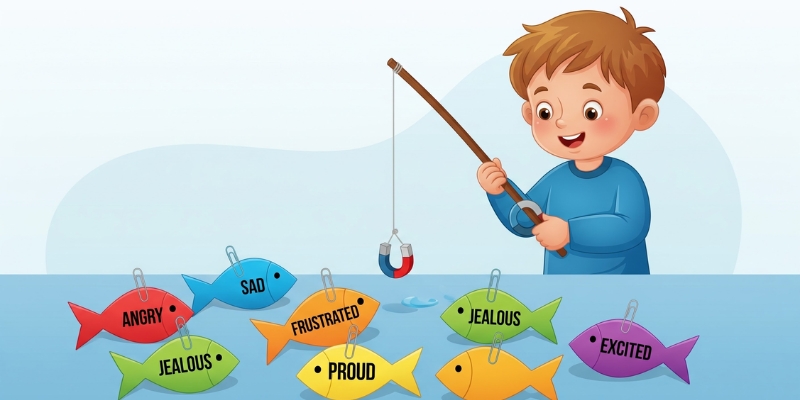
- How to Do It: Create paper fish and write different emotions on them (angry, sad, frustrated, jealous, proud, excited). Attach a paperclip to each and use a magnet on a string as a “fishing rod.” When your child catches a fish, talk about a time they felt that emotion. You can say, “Oh, you caught ‘Frustrated’! Tell me about a time you felt frustrated today.”
- The Lesson: This game normalizes all feelings and helps children identify that they can feel multiple, sometimes conflicting, emotions at once. It builds their emotional vocabulary in a low-pressure, fun way.
Body Mapping
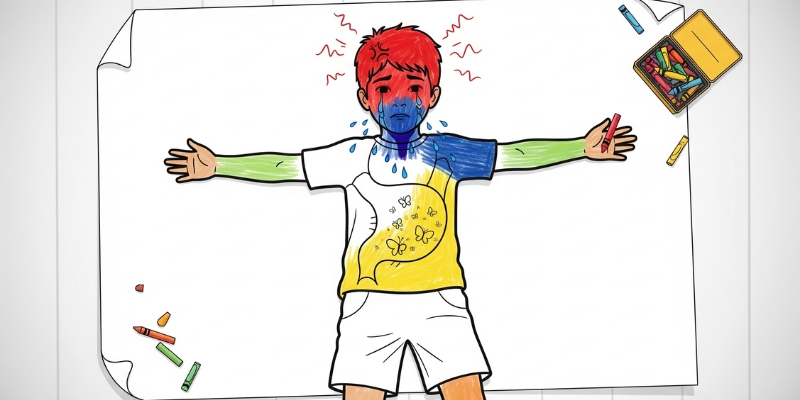
- How to Do It: Give your child an outline of a human body (or have them trace their own). Ask them to use different colored crayons to show where they feel different emotions in their body. They might color their head red when they have angry thoughts, their throat blue when they feel like they’re going to cry, or their stomach yellow with nervous butterflies.
- The Lesson: This activity, used in programs like Mightier, helps children recognize the early physical warning signs of anger. They learn that their body gives them clues, and they can learn to listen to them.
2. Art & Externalization Activities
Art allows children to express what they can’t yet say with words. It externalizes the feeling, making it something they can look at, talk about, and manage from the outside.
Paint Your Anger
- How to Do It: Set up an art station with paper, paint, markers, and clay. Encourage your child to create what their anger looks like. Is it a red monster with sharp teeth? A swirling black cloud? A hot, spiky ball? There is no right or wrong answer.
- The Lesson: This process of “externalization” helps separate the child from the emotion. They are not a “bad kid,” but a kid who is feeling anger, and the anger itself can be observed and managed. Once the “anger monster” is on paper, you can talk to it: “What does this monster need? How can we calm it down?”
Anger Charades

- How to Do It: Write down different scenarios or emotions on slips of paper (e.g., “mad about a broken toy,” “feeling left out,” “happy and excited”). Take turns acting them out without words, using only facial expressions and body language.
- The Lesson: This builds emotional vocabulary and empathy as children have to think about what different feelings, especially anger, look like in someone else. It also helps them see that everyone experiences these feelings.
Colorful Pages & Story Reading
- How to Do It: Use pre-printed coloring pages that depict calming scenes (like a peaceful forest or a quiet beach) or read books specifically about characters dealing with anger, such as Soda Pop Head by Julia Cook or When Sophie Gets Angry—Really, Really Angry… by Molly Bang. Pause during the story to ask questions like, “Why do you think the character felt so angry? What could they do to feel better?”
- The Lesson: This provides a non-confrontational way to explore triggers and responses. It gives children a narrative framework for their own experiences and introduces anger management strategies for kids through relatable characters.
3. Sensory & Kinesthetic Release Activities
For many children, especially those who are kinesthetic learners or have sensory processing sensitivities, anger is a physical experience that needs a physical outlet. Providing safe, acceptable ways to release that energy is crucial.
Safe Destruction Station

- How to Do It: Create a designated “mad space” with a stack of old newspapers to rip, a sheet of bubble wrap to pop, or a pillow to punch or scream into. You can even write the thing they’re angry about on a piece of paper before they rip it up.
- The Lesson: This provides an immediate, satisfying physical release for aggressive energy without causing harm. It’s a tangible way to help kids handle anger that feels good in the moment.
Active Movement Breaks
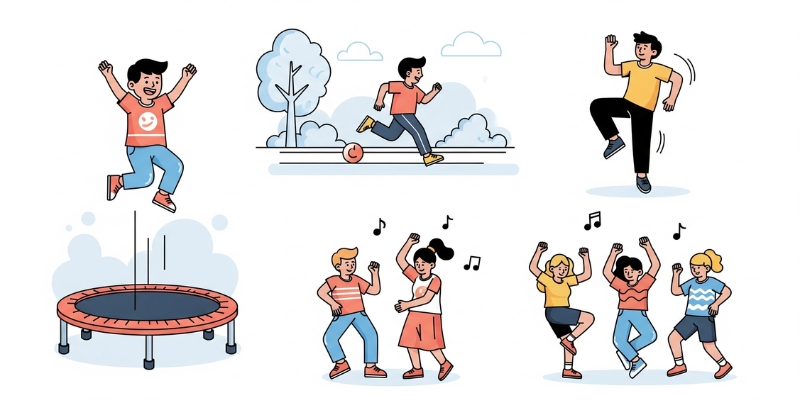
- How to Do It: When you see anger escalating, encourage jumping on a mini-trampoline, running a lap around the yard, doing jumping jacks, or having a 30-second “dance party” to loud music.
- The Lesson: This helps burn off the stress hormones (adrenaline, cortisol) associated with anger. Physical exertion is one of the fastest ways to change a physiological state.
Tactile Calming Tools
- How to Do It: Keep a “calm-down kit” filled with stress balls, therapeutic putty or playdough, a sensory bin filled with rice or kinetic sand, or a soft, fuzzy blanket.
- The Lesson: Kneading, squeezing, and sifting can be incredibly calming for a heightened nervous system. These activities provide a focal point for distraction and help regulate the senses.
4. Calming Tools & Games for De-Escalation
Create a “calm-down corner” or toolkit that your child can access independently when they feel big emotions rising. This empowers them to take charge of their own feelings.
Calming Down Cards
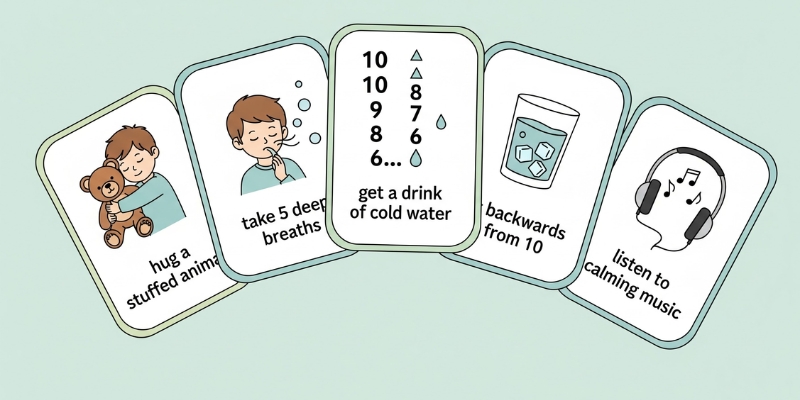
- How to Do It: Create a deck of cards with pictures or words depicting different anger management techniques for kids—”hug a stuffed animal,” “take 5 deep breaths,” “get a drink of cold water,” “count backwards from 10,” “listen to calming music.” When your child feels upset, they can flip through the deck and choose a strategy that appeals to them.
- The Lesson: It gives children a menu of choices and a sense of control when they feel out of control. The visual cue is easier to process than verbal instruction when they are emotionally flooded.
The Anger Thermometer

- How to Do It: Draw a large thermometer on a poster board. Help your child rate their anger from 1 (cool, calm, and happy) to 10 (explosive, out of control). They can draw or paste emojis for each level. Then, work together to write down a specific calming activity for each level (e.g., at level 3, take a deep breath; at level 5, squeeze a stress ball; at level 8, go to the calm-down corner).
- The Lesson: This tool helps children develop self-awareness by quantifying their anger. It teaches them that different intensities of anger require different responses, moving them away from an all-or-nothing reaction.
Interactive Worksheets & Digital Tools
- How to Do It: Printable worksheets from reputable sources like Therapist Aid (e.g., the “Anger Meter” or “Anger Warning Signs” worksheets) can help kids explore triggers and relaxation techniques in a structured way. Some families also find value in approved apps that teach mindfulness and breathing through games.
- The Lesson: These provide a more formal, reflective space for older children to analyze their anger patterns and understand the sequence of events that lead to an outburst.
Daily Practices & Routine Anger Management Techniques for Kids
Integrating simple, consistent practices into your daily routine builds emotional resilience over time, making big blowouts less frequent.
- Mindful Breathing Exercises: The goal is to make these exercises so familiar that they become automatic.
- Bunny Breathing: Take three quick, sniffling breaths in through the nose, then one long, slow breath out through the mouth.
- Belly Breathing: Have your child lie down and place a small stuffed animal on their belly. Instruct them to breathe in slowly to make the animal rise, and breathe out slowly to make it fall. This makes the abstract concept of deep breathing concrete and fun.
- Practice When Calm: The key is to practice these during calm, happy moments (before bed, in the car, after breakfast) so the skill is strong and readily available during moments of distress.
- The Mindful Pause: Create a family habit. When anyone in the family feels overwhelmed, they can call for a “mindful moment.” Everyone stops what they are doing, closes their eyes (if comfortable), and takes three deep, synchronized breaths together. This model suggests that everyone needs to regulate their emotions and that it’s a team effort.
- HALT Check-Ins: Teach your child the simple acronym HALT: Hungry, Angry, Lonely, Tired. When they seem upset or on the verge of a meltdown, gently ask, “Sweetie, let’s HALT. Are you feeling Hungry, Angry, Lonely, or Tired?” This teaches them to connect their mood to basic physical and emotional needs, fostering self-awareness and self-care from a young age.
Building a Supportive Environment: The Role of the Adult
Children are brilliant observers but poor interpreters. They learn how to handle emotions primarily by watching the important adults in their lives. Your involvement is the single most important factor in making these anger management activities for kids stick.
- Modeling Emotional Regulation: When you manage your own frustration with traffic by taking a deep breath and saying, “I’m feeling impatient right now, so I’m going to take a deep breath,” you are giving your child a powerful, real-time demonstration of emotional regulation for kids. Narrate your own process: “I’m feeling really stressed because the kitchen is a mess. I’m going to turn on some music and clean for 10 minutes to help myself feel better.”
- Validating All Feelings: Create a safe environment where all feelings are allowed. Avoid phrases like “Don’t be angry” or “It’s not a big deal.” Instead, validate: “I see you’re really angry that your tower fell down. It’s so frustrating when something you worked hard on gets ruined.” Validation is not the same as permissiveness; you are validating the feeling, not the behavior. This makes a child feel seen and understood, which alone can often de-escalate a situation.
- Co-Regulation: Before a child can self-regulate, they need to be co-regulated by a calm adult. When your child is in the throes of anger, your primary job is to be a calm, steady anchor. Get down to their level, use a soft voice, and simply be present. Your calm nervous system can help calm theirs. This might look like a quiet hug, sitting silently nearby, or offering a glass of water.
Tailoring Strategies for Different Ages and Personalities
It’s important to remember that a one-size-fits-all approach doesn’t work with children. Their needs and capabilities change dramatically as they grow.
- For Toddlers (2-4 years): Keep it simple and physical. Focus on naming emotions (“You are mad!”) and providing physical outlets (stomping feet, ripping paper, hugging). Their prefrontal cortex is barely developed, so reasoning is ineffective. Focus on redirection and co-regulation.
- For School-Age Children (5-9 years): This is the ideal time to introduce more complex anger management games for kids, emotion thermometers, and structured breathing exercises. They can start to reflect on what happened and why, especially after they have calmed down.
- For (10-12 years): They may be more self-conscious. Journaling, more private use of a calm-down kit, and collaborative problem-solving work well. Respect their growing need for autonomy while still providing a supportive structure.
- For Neurodivergent Children (e.g., ADHD, Autism): These children often experience emotions with greater intensity and may have more difficulty with emotional regulation. They may benefit from more frequent sensory breaks, even more explicit and repeated instruction of skills, and visual schedules that prepare them for transitions, which are common triggers.
When to Seek Professional Help
While anger is a normal part of childhood, there are times when it may indicate a deeper issue that requires professional support. Consider seeking help from a child therapist, counselor, or psychologist if your child’s anger:
- Is frequent, intense, and persists for several weeks or months.
- Leads to aggressive behavior that causes harm to themselves, other people, or pets.
- Results in the destruction of property on a regular basis.
- Is interfering with their ability to make or keep friends, or is causing major problems at school.
- Is accompanied by other concerning signs like persistent sadness, excessive worry, sleep problems, or extreme rigidity.
- Does not improve with consistent, patient use of strategies at home over time.
A professional can conduct a thorough assessment to determine if the anger is connected to underlying issues such as ADHD, anxiety, trauma, depression, or other behavioral conditions. They can provide tailored therapeutic support, such as:
- Cognitive Behavioral Therapy (CBT): Helps children identify and change the thought patterns that fuel their anger.
- Parent-Child Interaction Therapy (PCIT): Coaches parents in real-time to improve the parent-child relationship and manage difficult behaviors.
- Play Therapy: Allows a child to process emotions and experiences through the natural medium of play.
Seeking help is a sign of strength and an act of love for your child. Anger management classes for kids and teens offered by Mastering Anger can help them learn to control and channel their emotions constructively.
Conclusion: Building a Foundation for a Lifetime of Emotional Health
Helping your child deal with the powerful and confusing emotion of anger is one of the most significant gifts you can give them.
It is not about suppressing the emotion or creating a “perfectly behaved” child. It is about giving them the keys to understand, express, and manage their feelings in a healthy way.
By using these creative anger management activities for kids (from playful games and expressive art to daily calming techniques and your own empathetic modeling) you help your child with lifelong coping skills.
This consistent, patient, and loving approach transforms anger from a terrifying enemy into a manageable signal; a message from within that something is wrong and needs attention.
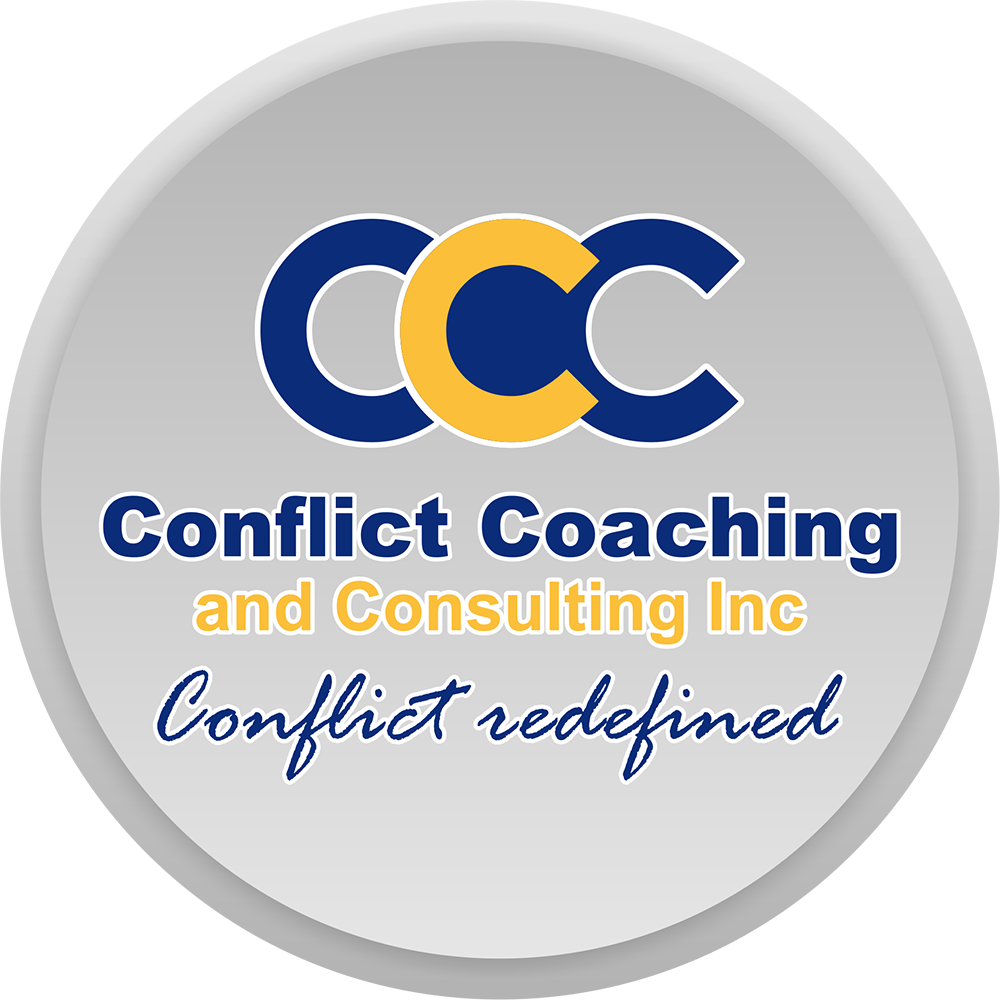




Responses